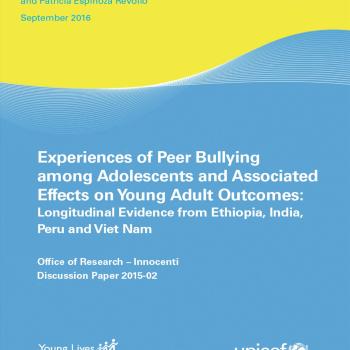Publication Information

Globally it is estimated that more than one in three students between the ages of 13 and 15 are regularly bullied by peers. Being bullied has been found to have a significant impact on children’s physical and mental health, psychosocial well-being and educational performance, with lasting effects into adulthood on health, well-being and lifetime earnings. Most research, including cross-cultural comparative work, has focused on high-income countries, identifying a range of predictors and effects associated with being bullied. Far less is known about bullying in low- and middle-income countries.
This paper is a contribution to the UNICEF Multi-Country Study on the Drivers of Violence Affecting Children, which analyses how structural factors interact to affect everyday violence in children’s homes, schools and communities. The results of the multi-country study intend to inform national strategies for violence prevention.
We use longitudinal data from the Young Lives study of childhood poverty to address three core questions:
Which children are bullied and how at age 15? What is associated with certain groups of children being bullied? Are there long-term associations between being bullied at age 15 with psychosocial indicators (self-efficacy, self-esteem, parent relations and peer relations) at age 19? Key findings:• Indirect bullying, such as measures to humiliate and socially exclude others, is the most prevalent type of bullying experienced at age 15 across three of the four countries, ranging from 15 per cent of children in Ethiopia to 28 per cent in India.
• Verbal bullying is also prevalent, affecting a third of children in Peru and a quarter in India.
•Physical bullying is the least prevalent form and lower than the other types, with the exception of India where the rate of children experiencing physical bullying is similar to other types of bullying.
•Boys are at greater risk than girls of being physically and verbally bullied and girls are more likely to be bullied indirectly.
•Poorer children are consistently more likely to be bullied in India and experience some types of bullying (physical, social exclusion and attacks on property) in Viet Nam than their less poor peers.

Globally it is estimated that more than one in three students between the ages of 13 and 15 are regularly bullied by peers. Being bullied has been found to have a significant impact on children’s physical and mental health, psychosocial well-being and educational performance, with lasting effects into adulthood on health, well-being and lifetime earnings. Most research, including cross-cultural comparative work, has focused on high-income countries, identifying a range of predictors and effects associated with being bullied. Far less is known about bullying in low- and middle-income countries.
This paper is a contribution to the UNICEF Multi-Country Study on the Drivers of Violence Affecting Children, which analyses how structural factors interact to affect everyday violence in children’s homes, schools and communities. The results of the multi-country study intend to inform national strategies for violence prevention.
We use longitudinal data from the Young Lives study of childhood poverty to address three core questions:
Which children are bullied and how at age 15? What is associated with certain groups of children being bullied? Are there long-term associations between being bullied at age 15 with psychosocial indicators (self-efficacy, self-esteem, parent relations and peer relations) at age 19? Key findings:• Indirect bullying, such as measures to humiliate and socially exclude others, is the most prevalent type of bullying experienced at age 15 across three of the four countries, ranging from 15 per cent of children in Ethiopia to 28 per cent in India.
• Verbal bullying is also prevalent, affecting a third of children in Peru and a quarter in India.
•Physical bullying is the least prevalent form and lower than the other types, with the exception of India where the rate of children experiencing physical bullying is similar to other types of bullying.
•Boys are at greater risk than girls of being physically and verbally bullied and girls are more likely to be bullied indirectly.
•Poorer children are consistently more likely to be bullied in India and experience some types of bullying (physical, social exclusion and attacks on property) in Viet Nam than their less poor peers.

